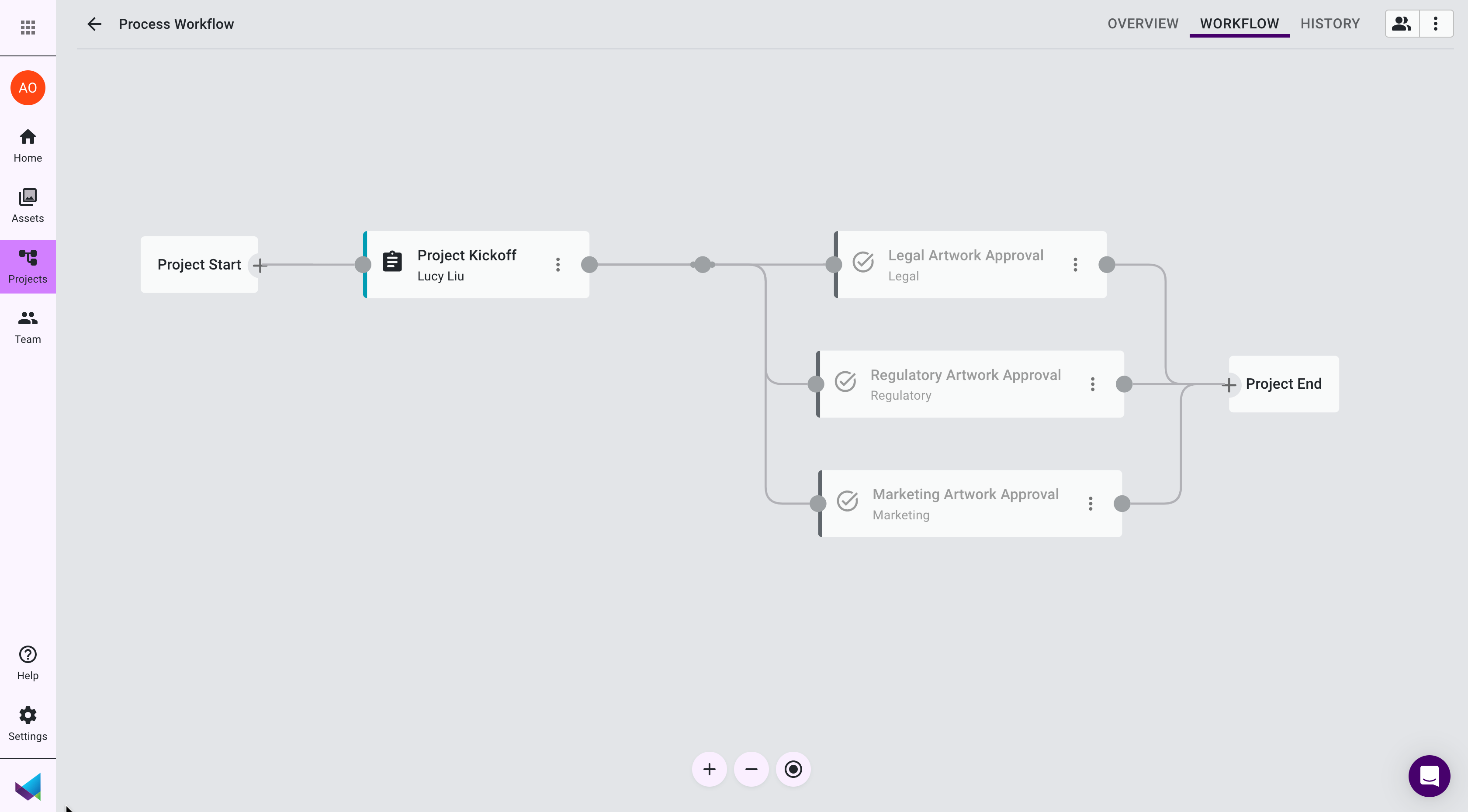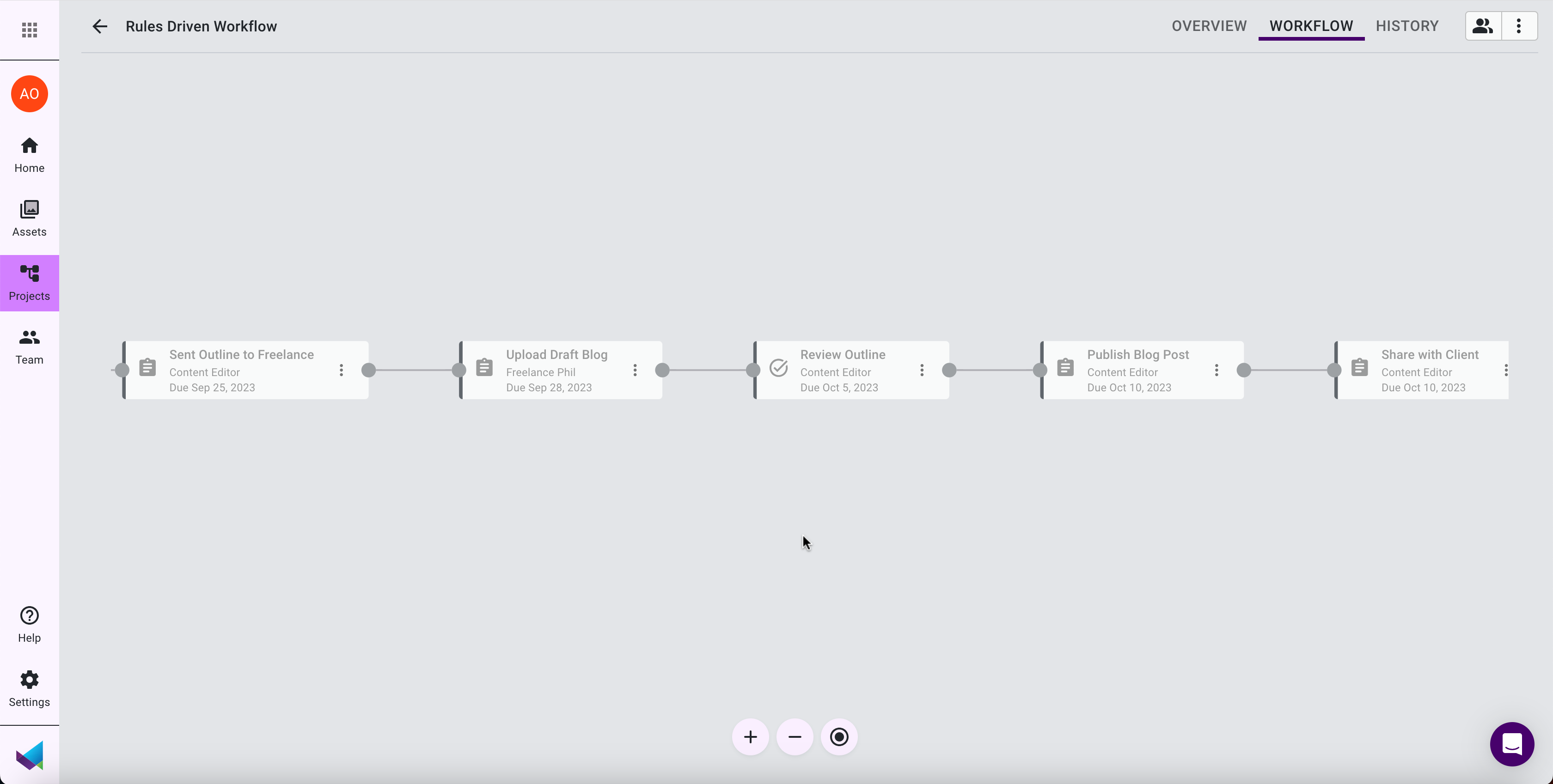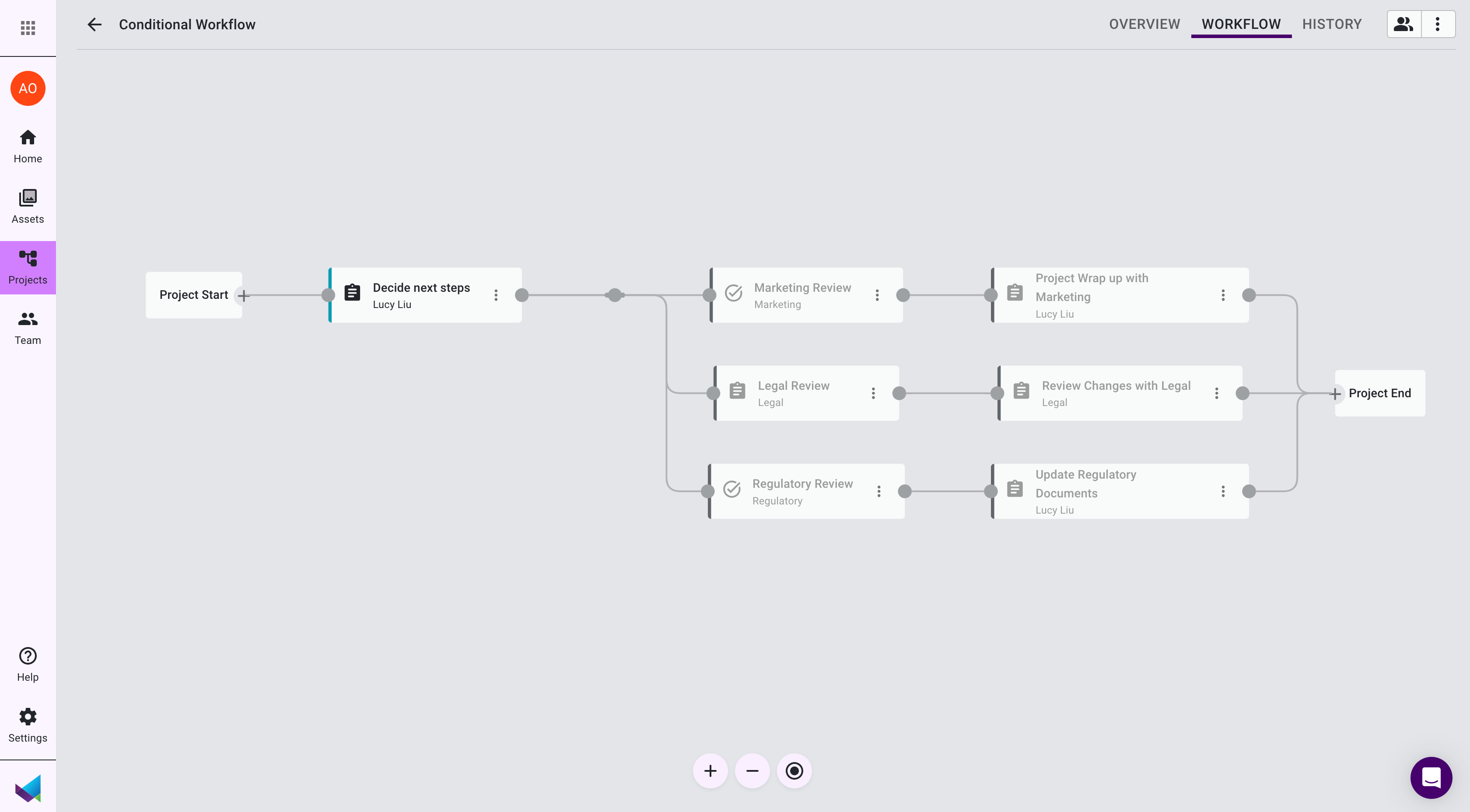Share this
8 Project Workflow Examples for Businesses
by Mox on September 20, 2023

Artwork design and approval projects become impossible to complete without clear direction. Luckily, there's something you can do about it.
In this guide, we introduce you to project workflows: structured sequences designed to boost efficiency and help you reclaim your time when managing artwork projects.
Below, you'll discover different types of project workflows, some project workflow examples across various industries, and actionable planning steps.
Table of Contents
- What Is a Project Workflow?
- 4 Types of Project Workflows
- 4 Project Workflow Examples for Businesses
- How Do You Plan a Project Workflow?
- Planning Workflows Inside of Mox
What Is a Project Workflow?
A project workflow is a structured roadmap that outlines a sequence of tasks, driving a project from inception to completion. It acts as the backbone of any organized project.
Benefits of Project Workflows
Adopting a project workflow brings several distinct advantages:
- Efficiency and effectiveness: Workflows streamline projects, facilitating better team collaboration.
- Customization: It's easy to tailor the workflow to your project's specific requirements.
- Error reduction: Workflows avert mistakes and enable quick error correction.
- Enhanced connectivity: Project workflows seamlessly integrate teams, tools, and culture.
- Elevated productivity: You can easily automate routine tasks, freeing up valuable time.
- Elimination of redundancy: Workflows enable you to focus on what truly matters, cutting out mundane tasks.
- Streamlined task management: You can consolidate all project-related tasks for easier management.
- Transparency and control: Workflows clarify roles and foster transparency.
- Positive work culture: Project workflows encourage teamwork and focus, making business goals more attainable.
Investing in a project workflow can significantly improve project outcomes and team performance.
4 Types of Project Workflows
Selecting the appropriate type of workflow is critical for project success. Let's dive into four key types of project workflows.
#1. Process Workflow
Source: Integrify
A process workflow is like a well-choreographed dance with predictable and repetitive steps. It's the go-to choice when you already know the exact path your project should follow from start to finish. Imagine it as a streamlined highway with clear lanes.
Use Cases and Benefits
- Unlimited scalability: Process workflows can handle many items or tasks flowing through them. Take, for instance, an artwork approval workflow—it sets its path early on and can efficiently process any number of requests within a single workflow.
- Flexibility with rules: These workflows allow you to build your business process logic without forcing you into predefined software steps. This means you can intelligently assign roles, manage tasks, and control the engagement or project according to your organization's rules.
- Efficiency in execution: Process workflows excel at routing documents, managing tasks, customizing questionnaires, and notifying users. This efficiency ensures that the right person is engaged at the right time, improving control, management, and visibility into your company's work.
#2. Rules-Driven Workflow

Source: Mageplaza
A rules-driven workflow is like having a smart assistant that knows what to do based on predefined conditions. It's all about the "if this, then that" logic.
These workflows adapt and react according to your rules, ensuring actions occur precisely when needed.
Use Cases and Benefits
- Automated routing: In response to triggers, rules-driven workflows seamlessly move projects to the next step, notify the responsible parties, and route documents to the right individuals.
- Task management: They create tasks, assign them with deadlines, and can even enforce certain tasks to be completed before progressing to the next phase.
- Customization: Rules-driven workflows allow you to tailor questionnaires, processes, or tasks based on specific conditions, avoiding irrelevant queries and ensuring tasks align with your project.
- Proactive notifications: Users receive timely notifications about new project developments or impending task deadlines. This keeps everyone in the loop and reduces manual follow-up.
#3. Conditional Workflow
Source: Workflow86
Conditional workflows are the "ifs" and "buts" of the project management world. They operate based on IF or IF/ELSE conditions, ensuring the workflow runs precisely when required and actions trigger only under specific circumstances.
Use Cases and Benefits
- Precision troubleshooting: Conditional workflows help streamline troubleshooting by ensuring all necessary details are in place, reducing the need for back-and-forth communications.
- Interconnected tasks: These workflows are handy when multiple tasks can occur simultaneously or depend on each other. They keep things on track despite delays in some sub-tasks, preventing disruptions.
#4. Parallel Workflow
Source: KnowledgeHub
Parallel workflows are the multitaskers of project management. They allow several tasks to run concurrently, making them ideal for dividing a complex project into manageable sub-tasks that can be tackled simultaneously.
Use Cases and Benefits
- Efficient division of labor: Parallel workflows work best for projects that can be broken down into independent sub-tasks.
- Task independence: Delays in one sub-task won't disrupt the entire process. Each component can move forward at its own pace, ensuring efficient project management.
Understanding these four project workflows gives you a powerful toolkit for choosing the right approach for your project needs. Whether you require predictability, adaptability, precision, or multitasking capabilities, there's a workflow type designed to enhance your project management journey.
4 Project Workflow Examples for Businesses
Let’s look at some project workflow examples essential to various business processes. Each example illustrates a real-world scenario, from artwork approval to product launches, designed to optimize efficiency and mitigate risk.
Understanding these models allows you to tailor workflows to fit your unique business needs.
#1. Artwork Design Workflow
An artwork design workflow is a systematic process that ensures your graphic designs align with client or project requirements. Plus, it helps you maintain professionalism throughout the project.
Here's a simple breakdown of the typical steps involved:
- Review the brief: Begin by thoroughly examining the project's creative brief, ensuring it covers essential information, such as company background, project goals, and timelines.
- Research the topic: Dive into market research beyond the brief, exploring previous projects, style guides, and competitor designs to align with branding and industry trends.
- Brainstorm ideas: Collaborate with your team to generate creative concepts that surpass client expectations. Use tactics such as mind mapping or rapid-fire brainstorming.
- Create a mood board: Develop a visual representation of your design concept, incorporating images, fonts, color palettes, and elements to guide project direction.
- Prepare sketches: Initiate rough design concepts based on brainstorming ideas and the mood board, laying the foundation for the final design.
- Get client feedback: Present design sketches to the client for feedback and direction, welcoming revisions to match their vision.
- Incorporate feedback: Make necessary revisions based on feedback, collaborating with colleagues and seeking internal input to address issues promptly.
- Present the final product: Ensure all deliverables are in order, align your work with the creative brief and client feedback, and provide the final output in the required format for client or stakeholder approval.
#2. Artwork Approval Workflow
Artwork approval processes are the backbone of creative projects, ensuring your designs are polished and ready for the world to see. These workflows involve multiple teams, such as marketing, legal, and packaging, and can span global and local collaborations.
Here are some steps typically involved in this workflow:
- Create a workflow and assign roles: Collaborate seamlessly by defining a clear approval workflow and assigning responsibilities to key stakeholders.
- Upload artwork to a management platform: Say goodbye to email mishaps and misplaced files. Use a centralized platform like Mox to securely share and track artwork.
- Review and revise: Streamline feedback and revisions within the platform, eliminating the chaos of scattered emails.
- Get approval and prepare for print: Easily track who has given the green light for printing, ensuring a smooth transition to the final stage.
#3. Marketing Workflow
Marketing teams thrive on efficiency; a well-structured marketing workflow is their secret weapon. It's a predefined set of steps that guide the team through creating marketing campaigns or projects.
Here's an example of some steps in a marketing workflow:
- Agency onboarding: To start, clarify finances and contracts, share project and company details, and hold a kickoff event.
- Project proposal: Create or request a detailed proposal outlining the agency's expertise.
- Creative brief: Develop a comprehensive brief as a blueprint for creative deliverables.
- Project scope: Define precise project goals through a scope statement.
- Project timeline: Agree on a transparent timeline to track progress and preempt challenges.
- Agency work: Let the agency commence work with your support as needed.
- Review and approval: Establish an efficient process for content review and approval, ensuring accurate feedback for project progress.
#4. Product Launch Workflow
Bringing a new product to market is a complex process that demands meticulous planning. A product launch workflow ensures that all necessary steps are completed systematically.
Here's a simplified example:
- Market research: Start by analyzing the market and identifying opportunities.
- Product development: Create the product, including design and how it functions.
- Marketing strategy: Develop a marketing plan to promote the product.
- Launch preparation: Set a launch date and prepare marketing materials.
- Launch day: Release your new product to the market.
- Post-launch evaluation: Analyze sales and customer feedback, and adjust marketing strategies as needed.
How Do You Plan a Project Workflow?
Planning a project workflow isn't just a preparatory step; it's the anchor that ensures seamless operation, maximizes productivity, and elevates your project from mundane to exceptional. Let's dive into the four steps you should take to plan your workflows.
#1. Create a List of Required Tasks
Start by listing all the tasks that need to be completed throughout your project. This step helps you gain a clear understanding of the scope and requirements. Make sure to be comprehensive and include even small tasks, as they can be critical.
#2. Assign Tasks & Key Responsibilities
Once you have your task list, assign each task to team members or key stakeholders. Clearly define responsibilities and ensure everyone knows their role.
You'll also need to decide if you plan to assign tasks to individuals or groups. If assigning tasks to a group, be sure to take note of what groups you'll need and who should be included.
This step fosters accountability and prevents tasks from falling through the cracks. Think of it as assembling a well-coordinated team for a successful mission.
#3. Develop a Workflow Diagram
A workflow diagram visually represents the sequence of tasks, dependencies, and milestones in your project. It's like having a map that guides you through the journey. A visual representation enhances clarity and facilitates better decision-making.
#4. Communicate the Workflow
Share the workflow with all key stakeholders. Effective communication is vital to ensure everyone understands the process and their roles. It's akin to setting clear directions for a group hike—everyone needs to know the path. Transparent communication fosters collaboration and minimizes confusion.
Planning Workflows Inside of Mox
Planning workflows can be a complex task, especially with artwork approval and project management. Fortunately, Mox provides a streamlined solution to simplify your workflow planning and management.
Mox offers several key benefits that make it a valuable tool for planning workflows:
- Clear visual workflows: With Mox, creating workflow diagrams is a cinch. These visual aids assist in understanding sequences, dependencies, and key milestones, resulting in easier decision-making and process optimization.
- Streamlined efficiency: Mox refines workflow management by driving smooth progress in projects involving packaging assets and artwork approval. It minimizes lag and ensures tight-knit collaboration among stakeholders, significantly reducing time-to-market.
- Default workflow templates: Built-in templates allow you to quickly visualize sample packaging workflows you can customize to suit your needs. As a result, you can get started right out of the gate.
- Enhanced team collaboration: The platform brings together design teams, stakeholders, and decision-makers. It's a communication hub where tasks are assigned, progress is tracked, and feedback is seamlessly shared.
- Transparent approval pathways: Mox shines in illustrating transparent artwork approval processes within its workflow diagrams. It leaves no room for ambiguity and clarifies who’s responsible for each stage of review and approval.
- Flexible workflows: There are no rigid workflows that constrain your team. You can easily adjust your workflows as you go by adding, removing, and modifying tasks as projects progress.

Whether you're involved in packaging artwork management, artwork approval, or general project management, Mox simplifies the planning and execution of your workflows. It's a versatile tool to enhance efficiency, collaboration, and transparency throughout your projects.

Create Artwork Approval Workflows Simply With Mox
Project workflows help you streamline tasks and enhance productivity. And with Mox, creating artwork approval workflows is a straightforward process.
If you're engaged in artwork approval or broader project management, Mox offers a comprehensive solution that prioritizes efficiency, collaboration, and transparency.
Ready to elevate your workflow strategies? Request a demo of Mox and experience the efficiency firsthand.

